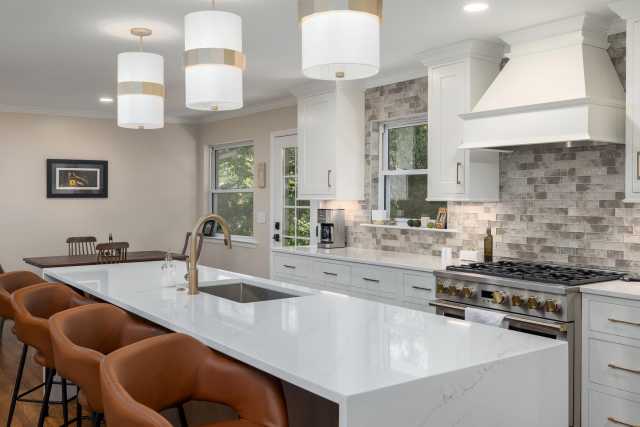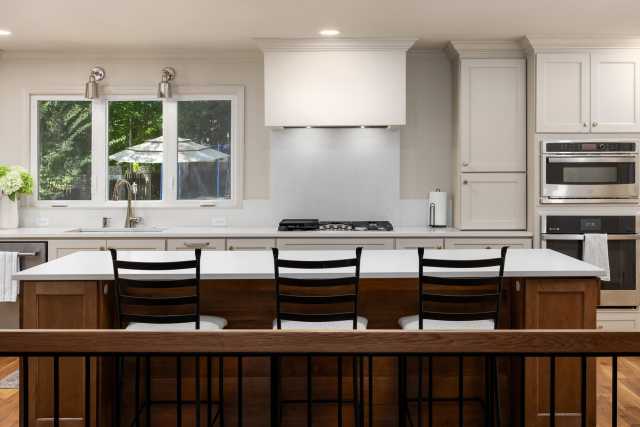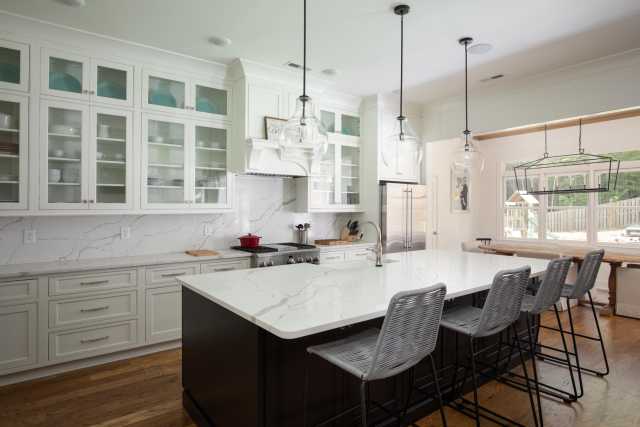The 2025 Custom Home: An In-Depth Analysis of Architectural, Technological, and Lifestyle Trends - part 3

Materiality and Aesthetics - The Look and Feel of 2025
The character of the 2025 custom home is defined by a rich and carefully curated sensory palette. The aesthetic choices of the moment are moving away from the cool, sterile minimalism of the past decade toward an atmosphere of warmth, authenticity, and deep personalization. This is a tactile revolution, where the feel of a surface is as important as its look. Materials are chosen for their natural character, textures are layered to create depth, and color is used to evoke specific moods, from serene and earthy to bold and expressive. This section details the materials, colors, and overarching design styles that combine to create the distinctive look and feel of the modern luxury residence.
A Tactile Revolution: The Embrace of Natural, Textured, and Imperfect Materials
A profound aesthetic shift is underway in 2025, prioritizing materials that are warm, authentic, and engaging to the touch. This trend represents a deliberate move away from the sterile, synthetic, and "faux" finishes that have been prevalent, seeking instead to wrap occupants in a "visual hug" created by rich textures and the inherent character of natural materials. �This is not just a visual preference but a multi-sensory one, where the tactile quality of a home's surfaces is a key component of its overall comfort and luxury. Natural materials are the foundation of this new aesthetic. Wood is paramount, with a distinct shift away from the cool grays of the past decade toward warmer, earthier wood tones. White oak, in particular, is favored for its light but warm character, while reclaimed and wire-brushed woods are used to add history and texture. �Stone, especially limestone and marble, remains a staple for its timeless sophistication, but is often chosen in honed or unfinished states to emphasize its natural, tactile qualities. �Brick, whether exposed in its natural state or painted, is also being celebrated for the rich, earthy texture it brings to both interiors and exteriors. �The emphasis is increasingly on locally sourced and plant-based options, reflecting a desire for materials that are both beautiful and environmentally responsible. Texture itself is taking center stage as a primary design element used to add depth, warmth, and visual interest to a space. �This is achieved by layering a variety of materials. Walls are being finished with tactile wallpapers like grasscloth, raw wood paneling, or even exposed brick. �Floors might feature the rich grain of wood, the varied pattern of stone-look tile, or the softness of a jute rug. �This layering continues with woven fabrics, velvet upholstery, and other textiles that invite touch and contribute to a cozy, inviting atmosphere. Integral to this tactile revolution is a celebration of the "handmade" and the "imperfect". �In an age of digital precision, there is a growing appreciation for the unique character that comes from human craftsmanship. This is seen in the demand for custom-made furniture, intricate woodwork, and hand-painted tiles, where slight variations are not seen as defects but as evidence of authenticity. �This philosophy extends to an embrace of "playful imperfection" in the materials themselves, where the natural knots in a wood plank or the uneven surface of a plaster wall are valued for the softness and character they bring to a space. �This focus on the authentic and the tactile is a direct response to the increasing digitalization of modern life, grounding the home in a sense of physical reality and sensory richness.
The 2025 Color Spectrum: From Earthy Palettes to Bold, Curated Hues
The color palette of the 2025 custom home marks a significant departure from the cool grays and stark whites that dominated the previous decade. The new spectrum is warmer, more complex, and deeply personalized, reflecting a collective desire for spaces that feel both grounding and expressive. The prevailing trends move in two complementary directions: a foundational embrace of nature-inspired earth tones, and a more adventurous use of bold, saturated colors as strategic, personality-driven accents.
The dominant trend is a clear and decisive shift toward warm and earthy tones inspired by the natural world.�This includes a rich and varied palette of deeper grays, muted greens like olive, warm browns, soft terracottas, and rich jewel tones such as sapphire blue and emerald.�National home builder Taylor Morrison, for example, selected "Clove" (SW 9605), a rich, warm, and earthy tone, as a foundational color for its 2025 collection, signaling a broad market move in this direction.�These colors are used to create a sense of tranquility and connection to the environment, mirroring the tones of forests, deserts, and mountains.In parallel with this earthy base, there is a growing confidence in using bold, personal color choices to inject personality and create dynamic focal points within the home.�This is a move away from "safe" neutrals toward more expressive and individualistic interiors. A specific technique gaining popularity is "color drenching," where a single, often bold, color is used across multiple surfaces in a room—including walls, trim, cabinetry, and even the ceiling.�This creates an immersive, cozy, and highly curated environment that makes a strong design statement.Several specific colors and materials are being called out as particularly noteworthy for 2025. Yellow is predicted to see a major resurgence, with its cheerful and optimistic character resonating with the current mood; Dulux's selection of "True Joy" as its color of the year is a key indicator of this trend.�Deep, rich colors like burgundy and teal are also emerging, often associated with the revival of Art Deco-inspired furniture and its sense of vintage luxury.Finally, in the world of metallics, a notable shift is occurring. After years of dominance by warm metals like brass and gold, cooler tones like silver, stainless steel, and nickel are making a quiet but confident comeback.�These metals offer a sleek, modern elegance that provides a crisp counterpoint to the warmth of the prevailing wood and earth tones. Silver accents are being used in lighting fixtures, faucets, and cabinet hardware to create a balanced, contemporary look that feels fresh and sophisticated without being cold or harsh.
Style Synthesis: In-Depth Analysis of Prevailing Aesthetics
While deep personalization is the ultimate goal, the design landscape of 2025 is defined by several prominent architectural and interior design styles that serve as powerful frameworks for creating a modern custom home. These styles are not rigid formulas but flexible starting points, often blended and adapted to suit individual tastes and regional contexts. The most influential aesthetics include the enduring Modern Farmhouse, the serene Japandi hybrid, the versatile Transitional style, and a nostalgic revival of "cozy" and "Old-World" charm.
- Modern Farmhouse: This style continues its reign as a top choice for exterior elevations across the country, beloved for its ability to blend welcoming, traditional character with clean, contemporary lines and modern functionality.
- Defining Features: The exterior is characterized by classic elements like gabled roofs, inviting covered porches (often wraparound), and vertical board-and-batten or horizontal lap siding.�A crisp color palette, typically white or off-white with black or dark accents on windows and roofs, is common.�Inside, the Modern Farmhouse embraces open-concept living, with spacious kitchens that flow into family rooms.�Interior details often include rustic touches like exposed wood beams, shiplap walls, and a mix of natural wood, metal, and stone accents.
- Examples: This highly popular style is offered in a vast range of floor plans by national and regional builders, from cozy 1,200-square-foot cottages to sprawling 4,000+ square-foot estates, demonstrating its wide appeal and adaptability.
- Japandi: A sophisticated hybrid style that is rapidly gaining traction, Japandi masterfully fuses the minimalist elegance of Japanese design with the rustic comfort and functionality of Scandinavian aesthetics (often referred to as "Hygge").
- Defining Features: The core principles are simplicity, clean lines, and uncluttered spaces. �The style emphasizes a strong connection to nature and a seamless indoor-outdoor flow, often achieved through interior courtyards, large windows, and sliding doors. �The color palette is neutral and earthy, while the material palette celebrates natural materials, often contrasting the light woods of Scandinavian design (like white oak) with the darker, richer woods of Japanese tradition. �A deep respect for craftsmanship and the beauty of imperfection (the Japanese concept of
wabi-sabi) is central, favoring handmade items over mass-produced ones. - Examples: The Morelle House, a renovation of a 1970s brick home, serves as a prime case study. It was transformed using Japandi principles, featuring an internal courtyard with a vertical garden, bespoke timber accents, and a focus on natural light and materials to create a tranquil, minimalist oasis.
- Defining Features: The core principles are simplicity, clean lines, and uncluttered spaces. �The style emphasizes a strong connection to nature and a seamless indoor-outdoor flow, often achieved through interior courtyards, large windows, and sliding doors. �The color palette is neutral and earthy, while the material palette celebrates natural materials, often contrasting the light woods of Scandinavian design (like white oak) with the darker, richer woods of Japanese tradition. �A deep respect for craftsmanship and the beauty of imperfection (the Japanese concept of
- Transitional: This versatile and widely popular style acts as a bridge between traditional and contemporary design, offering a balanced and timeless aesthetic. It achieves this by updating classic architectural forms with modern materials, cleaner lines, and open floor plans.
- Defining Features: Transitional design can take inspiration from a variety of traditional styles—such as Farmhouse, European, or Craftsman—and streamline them for a more modern sensibility.�Key features include open-concept interiors, large windows that flood spaces with natural light, and a sophisticated mix of materials, such as pairing traditional stone or brick with modern steel accents, or classic crown molding with contemporary lighting fixtures.�The interior palette is typically neutral and calming, with visual interest and warmth created through the layering of diverse textures.
- Examples: Because of its inherent flexibility, the Transitional style is not tied to a single house type. It can be seen in everything from updated farmhouses to modern classics and is well-suited to a wide range of settings, from scenic lakefront properties to traditional suburban neighborhoods.
- "Cozy" and "Old-World" Revival: As a direct reaction against the stark, and sometimes cold, minimalism of recent years, a significant trend has emerged that champions comfort, nostalgia, and layered, historical character.
- Defining Features: This aesthetic is less a formal style and more a feeling. Zillow reports a 35% year-over-year increase in property listings that mention the word "cozy". This translates architecturally into a preference for smaller, more intimate, and often color-saturated rooms over vast, open spaces.�It incorporates aesthetics like "Rom-com Core," which uses natural materials and muted, earthy tones to evoke a feeling of cozy nostalgia.�This trend also includes a full-blown revival of classic English country style, with features like rich wood cabinetry, large range alcoves, floral patterns, antique furnishings, and the re-emergence of the scullery, or second kitchen.
These prevailing styles are not mutually exclusive. The overarching emphasis on personalization means that clients and designers are increasingly blending elements—creating, for example, a home with the gabled roofline of a Modern Farmhouse, the minimalist interior and natural materials of Japandi, and the spa-like bathroom of a high-end wellness retreat. The "style" has become a flexible framework for achieving a unique and personal vision, rather than a rigid set of rules to be followed.





